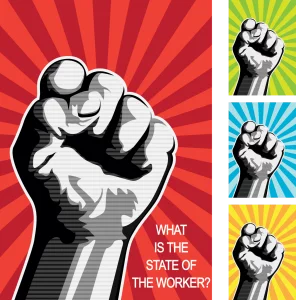Labor Day and the State of the American Worker: Is Talent Management the Solution?

As many of us celebrate Labor Day it’s easy to chalk it up to another holiday that means a long weekend, but at its core, it’s about the American worker. The headlines pertaining to America’s workforce are mixed – some media outlets celebrate a significantly reduced unemployment rate from one that soared just a few years ago during the recession, while we see other headlines shouting of gloom and doom for the workers of today and the future.
There’s mention of the numbers that lurk below the unemployment rate – what about those long-term unemployed that have given up looking for work and left the job market altogether? There are still millions that struggle to find employment, and for the people that are working, there seems to be a general sense of discontent.
Disengagement and a Skills Gap

On the eve of Labor Day, Gallup released their comprehensive report – aptly titled “State of the American Workplace.”
The report highlights the following:
- 7 in 10 American Workers are not engaged or actively disengaged from their job – meaning a lower rate of productivity.
- Companies with higher levels of engagement not only have higher productivity, but also more profitability, better customer ratings, less turnover, less missed days of work and less safety-related accidents in the workplace.
- According to estimates from Gallup, employee disengagement costs the U.S. anywhere from $450 billion to $550 billion per year.
- Less than half – 41% of American workers say they know what their company stands for and how that differentiates them from the competition.
This sense of disengagement from one’s job is simultaneously paired with a sense there’s a skills gap between what American companies are looking for, and what the country’s workers have to offer. It seems to be a unique and challenging situation when there’s millions of people unemployed, yet companies are struggling to fill so many open positions. Download free report on Bridging the Skills Gap.
The U.S. Chamber of Commerce found 53 percent of small business leaders had challenges filling jobs and last year, Inc. 5000 CEOs were surveyed and of those leaders, 76 percent said they had a major problem finding qualified people.
A Shift in Thinking
So which school of thinking are we to believe? Is the job market a black hole of discontent and a shortage of opportunities, or is it thriving and growing as long as you have the right skills?
The answer may be both, but it’s not just up to American workers to make the changes necessary to fit what’s needed of them in today’s workforce.
According to Forbes, in a report on how they saw 2014 shaping up in terms of the labor market, companies are going to be shifting from simply focusing on how to lower their costs, to how to engage and retain their employees.
The belief from Forbes and many other industry experts and media outlets is that in order to remain competitive, American companies are going to have to become innovative and start viewing employees as their most valuable resource. That means empowering employees and fostering their sense of engagement in their work.
Additionally, as predicted by the Forbes report, there’s also a focus on attracting talent – particularly in terms of leadership.
The Solution: Talent Management
As we’re seeing this continual sense of disengagement, more and more companies are willing to focus on their employees and nurture them—because a happy workforce doesn’t just make your company an enjoyable place to come every day, but it’s also the best way to improve your bottom line.
According to Gallup’s report, one of the primary ways the top companies differ from others is their dedication to employee development and on-going learning opportunities. Gallup says employee engagement begins from day one on the job, and the best companies not only have comprehensive and well-defined leader and manager development programs, but they incorporate engagement, on an individual and team level, within all of these programs.
According to Forbes, another part of the talent solution relies on creating a talent supply chain. We’re seeing a focus on building “capabilities” as Forbes dubs it, rather than the standard training, and much of that capability development is focused on providing continual learning and development opportunities. This continual development is being paired with revamping of appraisal systems, which allows companies to continuously realign their evaluation of employee performance to ensure its in-line with changing goals, along with coaching and development.
All of this is being simplified for corporations thanks to the availability of eLearning or learning management systems (LMS). The corporate talent management and development eLearning industry grew 17% in 2013, and that’s a number that will likely continue to grow as companies both large and small are growing cognizant of what it’s going to take to remain competitive in a global marketplace.
Today, the success of individuals, companies and the entire American economy and workforce depends on a willingness of these corporations to recognize and develop talent. This is more important than attracting and retaining employees than even cushy benefits, and new technological innovation in the form of eLearning is providing an efficient, effective and inexpensive way to maintain that talent development cycle.